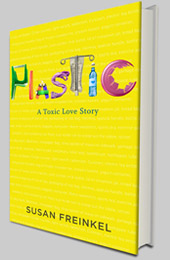Daniella Russo, a co-founders of the Plastic Pollution Coalition, was in Rio de Janeiro last week for the Rio+20 2012 Earth Summit. I asked her about what did –and didn’t — happen at the international gathering:
Q: What were you hoping to accomplish at Rio?
A: My greatest wish was to put the issue of plastic pollution on the map of major issues on the path of sustainability. I also was hoping to get a better understanding of how other nations and NGOs view this issue. We had a very difficult time getting the organizers of the summit on board with the concept that plastic pollution was inconsistent with an Earth Sustainability summit, so the hope was again to bring the issues to the attendees and the delegates.
Q:How was the issue of plastic pollution addressed there?
A: The conference made a tiny effort to reduce plastic pollution, despite our repeated efforts to bring hydration stations, refillable bottles and utensils made from natural materials. It was not difficult logistically, but they did not deem it a priority.
During the sessions plastic pollution was mentioned often but quickly repositioned by the plastics industry and other businesses as a problem that can be resolved with more recycling. This was true during sessions organized by UNEP [the United National Environmental Program] about marine trash, as well as other sessions focusing on sustainable living. It was clear that there was little or no understanding of the toxic nature of plastic, and the particular danger to human health they represent.
Q: Yet according to the tweetosphere, plastic was the top issue people were talking about?
A: Yes, but in carefully calibrated terms as a problem that can be managed by end of life programs. It will take a lot more education for people to understand the true costs of plastic pollution to society and to human health. That said, plastic pollution appeared in all ocean discussions, in all sustainability discussions and in all waste management conversations.
Q: The final document summarizing conferees’ vision for the future contains a reference to the danger plastic poses to the health of the oceans. But you’ve said it was a struggle to get the word “plastic” included in that document . Why was it so hard to get recognition?What were you hoping to accomplish at Rio?
A: There is a huge and well organized opposition to any group who tries to focus on the unique dangers of plastic. The general push is to bundle plastic with rest of waste and thus diminish its importance. Plastic, unlike all other materials, is totally inert and cannot be handled as rest of waste. It is also toxic. This tends to also be overlooked, despite all international bans on BpA and toxic chemicals leaching from plastics. The most visible aspects of plastic pollution are the ones that get people to talk – the environmental impacts. We worked hard to educate as many people as possible on the dangers, and even so it is hard to get the many facets of the issue to the surface.
We are however pleased with the progress, although we need to be moving much faster towards a complete recognition of the issue, in order to get action.
Q: Several groups sponsored a side event, Plasticity 2012, to spur innovative thinking about solutions to the problems posed by plastic. Can you tell me a bit about what was discussed?
A: There were three types of discussions:
* front end solutions, such as businesses that work on products to eliminate plastic waste: bioplastics, change in packaging / product design, and new generation of products: Pylantis, MyReplenish, LifeFactory, as well as Mycobond
* source reduction policies: As You Sow, Gaia, ReciColeta Brazil
* economics and environmental capital: how investors have a unique opportunity to address these environmental challenges while creating substantial shareholder value by
investing in clean energy and technologies. (Go to Plasticity for more about the speakers and the program.)
Q: The Forum was designed to create a community of stakeholders– so where do you see that movement going next?
A: A good question. Further discussions took us into the creation of a semi-collaborative of stakeholders about ocean health. It’s a first step down the path of collaboration. I will report on this when I see the final matrix of collaborators and topics we created. It is a promising step in the right direction; collaboration is definitely key.




Well, thanks for following this not-very-consistently-posted blog.